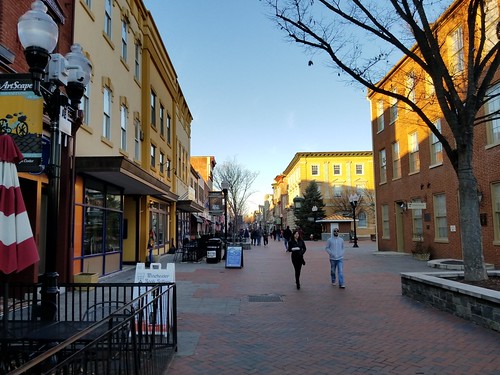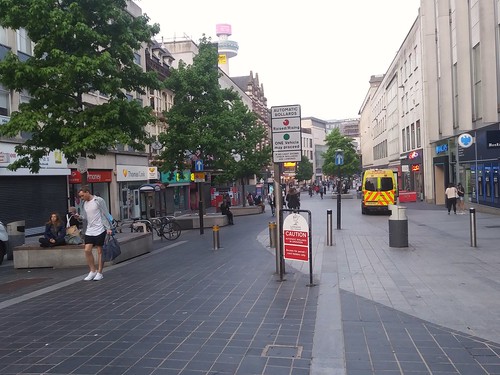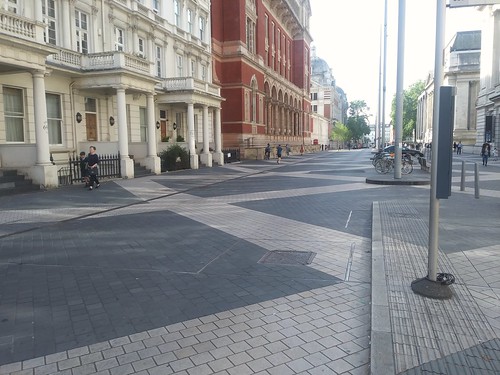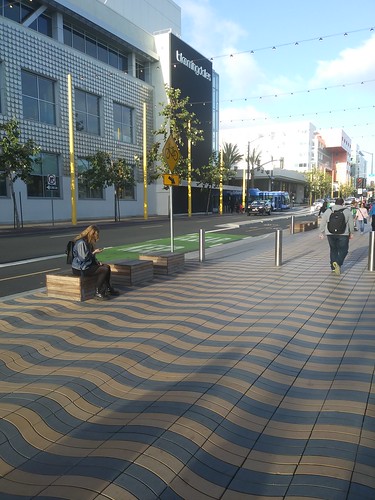More about making 17th Street between P and R a pedestrian space on weekends
This entry is an expansion of Item #6 in "Planning urban design improvements at the neighborhood scale: Dupont Circle, DC."
=========
More and more, out of the idea of promoting sustainable mobility and walkability especially, I now believe that the city needs to create more small sections of pedestrian prioritized spaces, and that like how 7th St. from Pennsylvania to North Carolina Avenues SE is closed in front of Eastern Market on weekends (below), so should 17th St. between P and R.

The idea is to support those areas of the city that are already highly pedestrian oriented. Because the typical pedestrian mall is many blocks long, and a pedestrian district can encompass 20-50 blocks, I couldn't see implementing pedestrian spaces at that kind of scale in the US. But there are a number of places that can support a "pedestrian district" for one to four blocks, at least in the temperate months.
The Dupont Circle neighborhood is a premier example, as we can see from its WalkScore rating.

Montreal creates similar pedestrian districts in the summer, although they also have 24/7/365 pedestrian areas in their Old Port and by McGill University. It's called Aires Libres -- free air.
St. Catherine Street, the heart of the "Gay Village," is pedestrian-exclusive during this roughly four month period although some shop owners believe it hurts their business. It is the site of an art fair for part of the period, and is programmed at other times, along with art installations ("Aires Libres 2019 - The Montreal Gay Village continues to shine as an LGBTQ and contemporary art beacon ," press release).

Pedestrianized spaces need to be actively managed and programmed. For a weekend pedestrian district to succeed on 17th Street, it would need to be programmed and managed, and in terms of programming, if it is open all year, for all four seasons of the year.
The experience with such places is that they need to be managed to be successful, the pedestrian mall in Boulder ("Now I know why Boulder's Pearl Street Mall is the exception that proves the rule about the failures of pedestrian malls," 2005) and the Third Street Promenade in Santa Monica ("Third Street 3.0 in Santa Monica," Los Angeles Business Journal) are good examples of this.

Third Street Promenade, Santa Monica
It could be a coalition of neighborhood groups, including Historic Dupont Circle Main Streets, the Dupont Circle Civic Association, merchants groups, the Dupont Circle BID, etc. The model for management would be what pedestrian malls and BIDs do.
In the region there are two ped malls in Charlottesville and Winchester. Both peter out at the ends in terms of success, but they are much longer, and don't have the immediately proximate population density of the Dupont Circle neighborhood.

But it could be a deal changer providing renewed oomph to the 17th St. commercial district, which faces massive competition from 14th Street especially as it has revitalized but also from Connecticut Avenue and Upper P Street. (An article in the Washington Post a few weeks ago, "Tom Sietsema’s 8 favorite places to eat right now," says Le Diplomate gets 3000 customers/day on the weekend. That's just one establishment on 14th St.!)
Monthly during the temperate months, restaurants in Denver's Larimer Square sponsor dining in the street.

Open Streets Project as a resource. The Open Streets Project is more focused on "temporary" street closures for walking, biking, and play, modeled after Ciclovia in Bogotá ("Bogotá closes its roads every Sunday. Now everyone wants to," Vox). But it could still be a useful resource. They offer manuals, case studies, etc.

Start by doing this from the Spring to the Fall. Rather than start off doing this for the entire year, I'd start smaller, like the Aires Libres summer program in Montreal, and just do this for the temperate months. Aires Libre is from mid-May to the third week of September. Since it stays warmer here a little longer, I'd suggest running it from mid-May to mid-October.

Yoga in Times Square, NYC.
Transportation demand management. A traffic plan, especially to accommodate deliveries, etc., would be required. Ideally, a kind of parking district could be created ("Parking districts vs. transportation/urban management districts: | Part One: Bethesda" and "Parking districts vs. transportation/urban management districts: Part two, Takoma DC/Takoma Park Maryland") to provide for parking in place of the spaces removed from 17th Street (I need to do a parking space count).
Traffic Safety: Install Retractable bollards. I would recommend installing retractable bollards at P, Q, and R Streets, using the model of Liverpool, although the Liverpool bollards are a lesser grade in terms of ideal security requirements (ability to withstand a vehicle traveling 50 mph), and properly rated bollards should be installed instead. (In Liverpool, there was a driver rage incident and he was able to crash through the bollards, because they didn't install bollards capable of resisting vehicles going at a high rate of speed. See "Special report: How Liverpool crowds could have been exposed to mass casualty terror threat despite a year of warnings," Liverpool Echo).

The way it's set up in Liverpool is that there is a priority delivery period for access in the morning, and access can be provided later, using a key card. There are safety lights that flash when the bollards retract and advance.
(I don't know why DC is resistant to installing bollards. Now it uses heavy vehicles to block streets when they are closed for special events.)
Special roadway materials treatments. Long term I'd recommend a special roadway materials treatment for the section. 7th St. SE is one example, as is Exhibition Road in London (below).

Half St. SE between M St. SE and the Nationals Stadium is also getting a special pedestrian oriented treatment.

Rendering showing special pedestrian urban design street treatment for Half Street SE, in the vicinity of the Washington Nationals Stadium
"Pedestrian fatalities and street design" discusses the concept of utilizing differentiated roadway materials other than straight up concrete or asphalt as a way to slow traffic and/or indicate a pedestrian-focused area.
Another great example, the sidewalk treatments on the Copacabana in Rio and Biscayne Boulevard in Miami (below), by Roberto Burle Marx.

In Santa Monica, Colorado Avenue leads to the Santa Monica pier and is perpendicular to the Downtown, and the location of the Expo Line transit. Both the sidewalk and street have special design treatments denoting their pedestrian-centricity.


Facilitating movement between the neighborhood and the commercial district without requiring a car. I'd recommend considering creating a combined people and delivery pick up and drop off service. What communities use is an electric vehicle usually with a capacity for 6 people, and they are primarily advertising sponsored.
Passengers at the beach on Arizona Street inquire about the new electric vehicle shuttle now available in Hollywood. The Sun Shuttle, operated by Circuit, is available for free in downtown Hollywood, on Hollywood Beach and along Federal Highway. To catch a ride, passengers can download the Ride Circuit app, wave down a driver, or go to a designated pick up location. (Mike Stocker / Sun Sentinel)
The idea is to move people between home and Metrorail stations and commercial districts without their having to drive.
A number of communities have contracted with an electric vehicle operator to provide this kind of mobility option. This article ("They’re like Uber but free: New electric shuttles popping up all over South Florida," Fort Lauderdale Sun-Sentinel) describes the different business models to pay for the service.
Integrating business district promotion organizations. The Dupont Circle Main Street program has been in operation for 16 years. Recently, a separate BID was formed ("New Dupont Circle BID names first executive director," Washington Business Journal) which I think is unnecessarily duplicative. There is no reason that "clean and space" and public space improvement initiatives couldn't have been added to the Main Street program.
It's important to separate the functions, principles, and operations of the commercial district management organization from the funding. In DC, BIDs are funded by an upcharge tax on commercial property. Main Streets raise funds independently as well as receive monies from the city.
In San Diego, they provide a standard way to fund such organizations: an upcharge tax on commercial property; but the business promotion group can organize however it wants, as either a Main Street program or a BID, and either can deliver clean and safe and transportation management programs, and public space improvements.
Green Benefit Districts. Another funding model, from San Francisco, is the Green Benefit District. It also includes residential properties (BIDs may include apartment buildings, and condominium buildings if a majority of owners agree), including individually owned houses, and provides additional funds to maintain neighborhood green spaces and sidewalks. Such a funding system could be implemented as well, to provide for better maintenance of such spaces in and outside of the commercial district sections of Dupont Circle.
Labels: bicycle and pedestrian planning, integrated public realm framework, neighborhood planning, urban design/placemaking




5 Comments:
I think the most important thing you wrote was to "start off small "
Partially this is to give people an opportunity to discover for themselves what a mall could do for their community , and let the concept grow .
The other part is that I sometimes wonder if American cities did things in oversized quantities , and while the concept may have been good , it was just too large until such time as the city wanted to extend it .
Not sure if you know the answer to this one , but -- how many cities in the US have a "successful" mall longer than 2 blocks ?
It would be better for every University town to have a modest ( one block ) ped mall -- even if they call it something else , than it would be to have numerous underutilised malls in larger cities ( especially those with downtowns that are not very pedestrian friendly eg Fresno )
Should you ever get down to visiting Australia , I recommend that you spend more time in Melbourne than Sydney . Sydney is fast getting more and more like LA , where as Melbourne is more chilled than SFO -- especially when it comes to malls , markets , light rail systems , urban preservation , café culture ethnic neighborhoods etc
Sydney's strengths are just a Wall Street on a beautiful harbour , with an airport which tries to be as congested as LAX.
there are two types. One is exclusive pedestrian. The other is what is called a transit mall, and is pedestrian plus bus exclusive.
Yes, I wouldn't know how many there are. But there aren't many exclusively pedestrian malls. I was really shocked to come across the one in Winchester. The prominent college town ones are Boulder, Burlington, Vermont, and Charlottesville. Santa Monica has one, but it's a beach town.
Prominent bus malls include Portland, Minneapolis, and Denver. Bus malls aren't that great. Buses are big and noisy. (Hamburg has one of those anchoring its bigger pedestrian district, whereas the ones in the US don't have broader pedestrian districts outside of the bus mall.)
It happens in the late 1980s I saw what had been the first one, in Kalamazoo, Michigan. It was dead.
The problem is that you need lots of pedestrians and in the era when suburban shopping malls were predominate, no one had any real need to go to the city, unless they worked there. Not to shop.
Besides the fact that there isn't enough money in the budget as it is to do all the things we need to do, if word got out especially in the Washington Post, we'd be skewered and the city would rescind the contract. "Study teams takes vacation on city's dime"
But the thing about the European cities I was fortunate enough to visit is that those cities are so pedestrian centric and dense at the core still, that the lessons for the most part, aren't transferable to here.
Only a handful of places in North America have the density and setup like that for markets to truly work. In the US, Manhattan, Brooklyn, Queens; Union Square and maybe another place or two in San Francisco; the Miracle Mile and a place or two in Chicago; Reading Terminal Market in Downtown Philadelphia; Pike Place in Seattle (as it is most of its visitorship is tourists) Boston, which has lower population than DC.
But it's related to this broad issue. How can you make it work? The pedestrian district in Liverpool is huge, many many blocks, at least 30. A typical pedestrian mall of old was at least six blocks.
But on Friday night when I was there, Liverpool's pedestrian district was teeming with people. I couldn't believe it. Especially because the area, generally, has a lot of poverty.
But Mare Street in Hackney Wick is only two blocks. So they don't have to be huge to work and be a valuable urban design intervention.
The area around the London Transport Museum is less than that. Exhibition Road in Kensington is open to cars but the section around the Underground station isn't and that's only around one block, etc.
That was the breakthrough for my thinking. Start small. Program it (we're not always good at that in the US). And be satisfied with a block or two that really thrives.
There is another piece I'll get to at some point which is something like "if the city really gave a s* about sustainable mobility, here are the high profile things that should be done to support pedestrians; bicyclists; and transit users."
The pedestrian section would include a list of areas able to withstand pedestrianizing, there are maybe seven.
Another is this idea I've been developing about taking sections of roads and treating subsections more as elements of the pedestrian network, like what I suggested for part of 16th Street in the Dupont Circle neighborhood.
Frankly, that is as transformative a concept as the revivification of ped blocks instead of ped malls. Transitways for buses. Great parking (not on the scale of Utrecht) for bikes -- basically, speaking of Melbourne, the Parkiteer concept of theirs, etc. There are 15-20 actions.
My definition of pedestrian malls are those which are exclusively pedestrian usage.
Wellington's main "transit mall" is next to the railway station, and pedestrians are expected to use the pedestrian tunnel (there is nothing stopping pedestrians from using the roadway , but bus drivers will honk their horn at any jaywalkers there ) There are one or two other parts of the CBD where the block is bus only, and pedestrians use the sidewalk.
"Quirky towns" eg San Luis Obispo and Santa Cruz are good candidates for pedestrian malls -- anywhere which encourages local business instead of corporate chains , and quite honestly , I think a town like Wall , SD would benefit from a ped mall in front of Wall Drug , even if it is for peak summer months . Any place that can attract people ( despite local population size )
I wonder about old mining towns that are slowly re-energising themselves
eg Bisbee AZ , or artist towns eg Sedona AZ ( I have been to the latter but not the former )
But in any case , the idea is to start out small , to show people the real potential of a mall that can be a placemaker spot , and let it grow to its potential capacity over time
One place where a pedestrian mall will NOT work , is Springfield , MO . There was/is no real downtown , but 3 or 4 oversized suburban malls which caters for cars and not people . I did not think much of that city at all -- even Cedar Rapids IA had more potential ( I have visited both )
re transit malls ….. Melbourne is unusual in that it has articulated ( double sized ) trams that rumble through their pedestrian malls every few minutes.
What is unusual is that it actually works ! The mall is a pedestrian mall , and the trams rumble through about 20 mph . Admittedly they are quieter than diesel busses ( and there are very few of them in Melbourne CBD ) but you cant always hear the trams coming -- I got caught out once trying to get a photo of a building and I was standing on the tramline ….
Brisbane has an underground transit mall under the CBD . People can not get any further than the doorway that opens only when a bus is ready to load up .
Sydney has transit malls on street level which just adds to congestion and noise . Usually adjacent to city underground railway stations .
The Asian cities that I have been to are usually more subway oriented , although have major bus infrastructure - although it is difficult / impossible to try to figure out the busses ( and Jakarta is a transport planners migraine headache , despite a BRT system of sorts and a one line subway or light rail -- which didn't exist when I visited that crazy city )
Lot to respond to here, not in order...
1. I hadn't thought about this for small towns. Of the ones you mention, I've only been to Sedona, and I think it would be tough, but still, it seems worth considering.
Like your point about Wall, SD, one of the places I think that should be pedestrianized in DC is G Street between 7th and 9th Streets. It would lead from the sports arena to "the central library" with the Smihsonian American Art Museum and National Portrait Gallery on one side.
- an advantage for 17th Street NW, like 7th Street SE by Eastern Market is that they are not used by present bus routes, so there would be no logistics crisis created by doing this.
- The Portland transit mall doesn't try to mix pedestrians with bus traffic. Either did the one in Hamburg.
But it has been redone since I've seen it. Then it was very hulking, as it had been developed out of urban renewal oriented design thinking.
I was just on the one in Denver briefly and like Nicolett Mall (but again, it's been redesigned since I've been there), the buses dominated, making it not particularly congenial, at least to me.
That's why your point about Melbourne trams, being electric powered and relatively quiet, is important.
Chattanooga doesn't have a ped mall, but they have a system of electric bus shuttles (they tried to make a manufacturing business out of it but nothing came of it and because of the Tennessee Valley Authority and electricity production, they are big on promoting electricity use) and I remember them being quiet.
Winchester Virginia is a "small" town, with a population about 30,000.
The pedestrian mall doesn't totally work, because there is still plenty of traditional mall and strip shopping center retail in the Greater area, but there are some decent businesses there.
They need to work very hard at recruiting and developing strong retail concepts.
E.g., about 25 miles away is a community in West Virginia called Lost River, and they had a kick butt brewpub (best chili I ever had--they used specially smoked meat). It didn't make it in large part because it couldn't draw on enough population (and they weren't good at marketing their beer outside of the immediate area).
But if it had been on the pedestrian mall in Winchester instead, I bet it would still be thriving today.
There is a university in Winchester, Shenandoah, but it isn't that big, 4,000 students. So the student population doesn't contribute much to the success of the pedestrian mall.
Still, it's a model for small towns to look at when considering opportunities to pedestrianize.
Post a Comment
<< Home